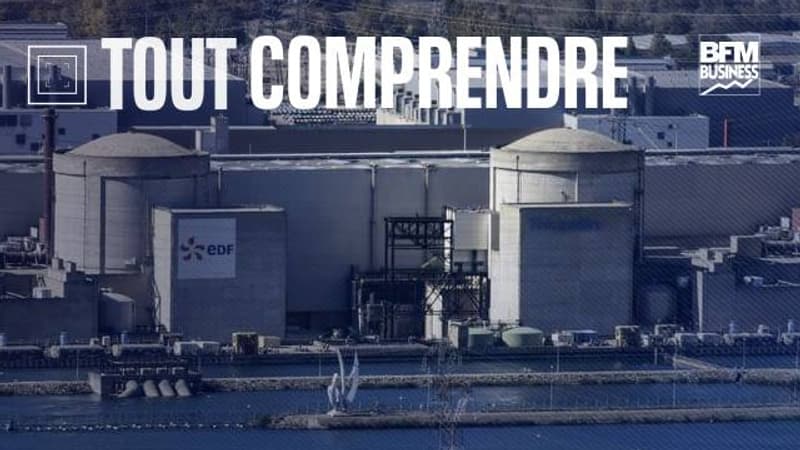The Government of Borne sticks to its nuclear calendar. A little over a month after the bill to speed up renewable energies that is currently being examined in the Senate, it is the turn of the one dedicated to the atom that will be presented this Wednesday in the Council of Ministers.
Not in vain, it contains the different guidelines given by Emmanuel Macron on the French nuclear strategy during his visit to Belfort last February and that the President of the Republic had more recently recalled on the sidelines of the inauguration of the first Hexagone offshore wind farm in Saint-Nazaire. BFM Business takes stock of this text called “EPR2 Project”.
• What are the objectives of the bill?
Like its counterpart on renewable energy, the nuclear acceleration bill is part of the government’s ambition to achieve carbon neutrality by 2050.
Parallel to the development of renewable energies, solar and offshore wind, France plans to act on nuclear energy to achieve this goal. To do this, six EPR 2 reactors will be built for a desired start-up between 2035 and 2037. The first pair of EPR 2 will emerge in Penly (Seine-Maritime) and its first stone could be laid before the end of the mandate of Emanuel Macron. The other two pairs will be in Graveline (North) and probably in the Rhône Valley, in Bugey or Tricastin.
Public debate about these three pairs of reactors is already underway. In the longer term, eight additional EPR2s could come out of the ground in accordance with the wishes of the President of the Republic. Preliminary work is currently underway to study potential locations, but also the problem of water sources. The Ministry of Energy Transition reports a “craze” from various sites, to volunteer to accommodate this new infrastructure as part of this second part of EPR2.
• How does Bill want to “speed up”?
Agnès Pannier-Runacher said it herself this Wednesday morning to the microphone of France Inter: “This text is about administrative procedures, it is not about how many EPRs in our energy matrix in 2050”. In short, the government wants to deploy the EPR2 project as quickly as possible and save several years in the implementation of future next-generation reactors thanks to improvements in procedures.
To go faster, several axes are mentioned. First of all, it is about reducing the number of authorization procedures to ensure that a single administrative decision is necessary and not a succession of decisions as is still the case today. The government also wants to accelerate the expropriation of vacant land and other sites not used by the owners that are in the vicinity of the future location of the EPR2. The Ministry of Energy Transition adds that no expropriation of homes will be carried out.
Finally, the executive expects to start part of the work without even waiting for the authorization to be issued, as soon as the environmental component is validated. This would then be preliminary work, like the earthworks prior to the office buildings that will surround the future reactors.
It is in this logic of facilitation that the new reactors will be placed in sites that already house nuclear infrastructures and this for two reasons, as Agnès Pannier-Runacher’s cabinet explained a few weeks ago: “First of all, convenience, because they will be easy to connect since the current is already present and then for the land, because EDF had already planned land reserves in the 1970s.
• Is there an environmental and democratic risk?
Several players are expressing fears about a nuclear strategy that could nullify or neglect certain steps in their target speed of execution. The general director of the League for the Protection of Birds (LPO) had indicated a “parody of consultation” on the various construction projects.
The Ministry of Energy Transition renews its desire to ensure public participation in the debate, to guarantee the protection of biodiversity around the sites, but also to avoid questions related to security. “The bill will not affect the depth of analysis of the security framework of the ASN (Nuclear Security Authority)”, indicated the minister’s office a few weeks ago.
Even so, the National Council for the Energy Transition (CNTE), which brings together unions, businessmen and even NGOs, “regretted the insufficient time” that it has been given to decide on the text that it has been aware of since September 26. The agency thus stressed that the bill “cannot prejudge the conclusions of the public cebat” when it is presented to the Council of Ministers.
• What is the legislative calendar?
A public debate, which is a legal obligation for EDF, will allow the French to express themselves on the construction of the six EPRs until February 27. Previously, the government is organizing another consultation, digital and broader, on energy until the end of the year. The 2050 scenarios of the network manager RTE and Ademe, which contemplate a variable share of nuclear energy, could serve as the basis for these two processes.
Regarding the legislative revision of the text, the government maintains its base in the first weeks of 2023 for its passage to the National Assembly so that the various provisions of the bill come into force during the second half of next year.
Source: BFM TV


